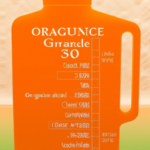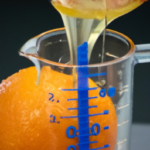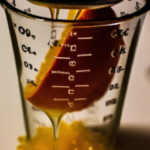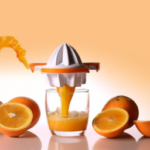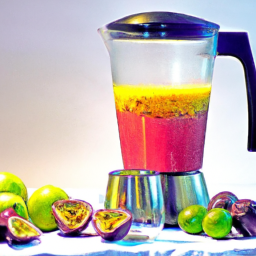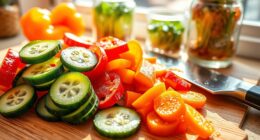As someone who enjoys the flavor of a refreshing glass of fresh orange juice, I have often wondered about how much juice can be squeezed from an orange. It seems that some oranges yield more juice than others. Research has shown that several factors can impact the amount of juice found in an orange.
In this article, I’ll explore those factors, provide an average estimate for the amount of juice in an orange, and share some tips for getting the most juice out of your oranges.
Understanding the juice content of an orange can be helpful for a number of reasons. For instance, if you’re making a recipe that calls for a specific amount of juice, you’ll want to know how many oranges to buy. Additionally, knowing how to get the most juice out of an orange can be useful for those who are trying to minimize waste or simply want to enjoy the full flavor and nutritional benefits of this popular citrus fruit.
So, let’s dive in and explore the fascinating world of orange juice!
Key Takeaways
- Valencia oranges have higher juice content than navel oranges, and selecting the right type of orange is essential for maximum juice content.
- Storing oranges at room temperature and avoiding direct sunlight can help preserve juice content.
- Oranges are packed with essential nutrients such as vitamin C, fiber, folate, and potassium, which offer various health benefits.
- Fresh orange juice yields about 1/3 cup of juice on average, and adding lemon juice or mixing with other fruits can create variations of orange juice.
Factors Affecting Juice Content
Want to know why some oranges have more juice than others? It all depends on a few key factors affecting their juice content!
The amount of juice in an orange can vary due to multiple factors such as the variety of orange, the ripeness of the fruit, and the growing conditions of the tree.
Different orange varieties have different juice content. For example, Valencia oranges are known to have a higher juice content than navel oranges.
The ripeness of the fruit also plays a crucial role in determining the amount of juice it contains. An underripe orange will have less juice, while an overripe orange will have a lot of pulp and less juice.
Finally, factors such as soil quality, temperature, and rainfall can also affect the amount of juice an orange contains. With all these factors in mind, it’s essential to select the right type of orange to ensure maximum juice content.
Now that we’ve explored the factors affecting juice content, let’s move on to the next section where we’ll delve into the average amount of juice in an orange.
Average Amount of Juice in an Orange
The succulent citrus fruit provides a refreshing burst of liquid with every squeeze. However, the amount of juice that can be extracted from an orange can vary depending on different factors.
One of the primary factors that determine the amount of juice in an orange is the variety of the orange. Some varieties, such as the Valencia orange, are known to contain more juice than others like the Navel orange. Other factors that can affect juice content include the ripeness of the fruit, the storage conditions, and the age of the orange.
Orange juice extraction is a delicate process that requires precision and patience. To get the most juice out of an orange, it’s important to choose the right variety and ensure that the fruit is ripe. Squeezing the orange gently and using a handheld juicer can also help to maximize the amount of juice you can extract.
Additionally, storing the oranges at room temperature and avoiding direct sunlight can help to preserve the juice content. With these tips in mind, you can enjoy a glass of freshly squeezed orange juice that is bursting with flavor and nutrients.
Tips for Getting the Most Juice
To get the most out of your citrus fruits, it’s important to choose the right tools and techniques for extracting all that delicious liquid gold. When it comes to juicing oranges, there are a few tips that can help you maximize your yield. First, selecting ripe oranges is key. Look for oranges that are heavy for their size, with firm, smooth skin and no soft spots. A ripe orange will also have a sweet fragrance and give slightly when gently squeezed.
Once you’ve selected your oranges, it’s time to start juicing! There are a few different juicing techniques you can use, depending on the tools you have available. One popular method is to cut the orange in half and use a citrus juicer to extract the juice. Another option is to use a handheld citrus reamer to manually juice the orange. Whichever method you choose, be sure to apply firm pressure and rotate the orange as you juice to extract as much liquid as possible. With these tips in mind, you’ll be well on your way to getting the most juice out of your oranges.
Now that you have your freshly squeezed orange juice, you might be wondering what else you can do with those leftover orange peels. Let’s explore some creative ways to use every part of the orange in the next section.
Other Uses for Oranges
After enjoying the refreshing taste of freshly squeezed orange juice, don’t throw away those peels! There are many creative ways to use every part of the citrus fruit. Here are four uses for oranges beyond just consuming the fruit itself:
-
Orange peels can be dried and used in homemade potpourri for a fresh, citrus scent throughout your home.
-
Create orange crafts by using the peels to make bird feeders or tea light holders.
-
Orange essential oil uses include adding it to a diffuser for a natural air freshener or using it in homemade cleaning products.
-
Orange peels can also be used in cooking, adding flavor to dishes like stir fry or infused into simple syrups for cocktails.
While oranges are often consumed for their juicy and sweet taste, the fruit and its byproducts have many uses beyond just consumption.
However, it’s also important to note that oranges do have numerous nutritional benefits, which will be discussed in the subsequent section.
Nutritional Benefits of Oranges
You’ll be happy to know that oranges are packed with essential nutrients that can help support a healthy lifestyle. One of the most well-known health benefits of oranges is their high vitamin C content. In fact, just one medium-sized orange can provide you with more than 100% of your daily recommended intake of vitamin C! This essential nutrient plays a crucial role in supporting the immune system, which is why many people turn to oranges during cold and flu season.
But vitamin C isn’t the only nutrient found in oranges. These citrus fruits are also a good source of fiber, folate, and potassium, among other vitamins and minerals. Fiber is important for digestive health, while folate is essential for cell growth and repair. Potassium, on the other hand, helps regulate blood pressure and can reduce the risk of heart disease.
With all these nutritional benefits, it’s clear that oranges should be a regular part of a healthy diet.
As we move into the next section about fun facts about oranges, it’s important to remember that these citrus fruits are not only delicious but also incredibly nutritious. So, the next time you enjoy a juicy orange, you can feel good knowing that you’re also supporting your health in a variety of ways.
Fun Facts about Oranges
Did you know that oranges have a fascinating history? These citrus fruits aren’t naturally occurring, but rather a hybrid of pomelos and mandarins. Oranges were first cultivated in China over 4,000 years ago and were brought to Europe by traders in the 15th century.
Today, oranges are grown in many parts of the world, including the United States, Spain, Brazil, and China. Here are three interesting facts about oranges:
- The world’s largest producer of oranges is Brazil, followed by the United States and China.
- There are over 400 varieties of oranges grown around the world, with some of the most popular being Valencia, Navel, and Blood oranges.
- Oranges aren’t just for eating – they can also be used to make fragrances, cleaning products, and even fireworks!
As we move into the next section about recipes and ideas for using oranges, it’s important to remember the rich history and variety of this versatile fruit. Whether you prefer to eat them fresh, use them in cooking, or enjoy their fragrance, oranges are truly a global favorite.
Recipes and Ideas for Using Oranges
I absolutely love using oranges in my cooking, and today I want to share some recipes and ideas with you.
Fresh orange juice is a great addition to any breakfast or snack, and it’s packed with vitamin C.
For a healthy and flavorful salad dressing, try making a simple orange vinaigrette.
And for a tasty and unique main dish, consider making orange-glazed chicken – the citrus adds a zesty twist to traditional chicken dishes.
Fresh Orange Juice
When squeezing a fresh orange, it’s amazing how much juice can come out of a single fruit. Here are some interesting facts about fresh orange juice that you may not know:
- On average, a medium-sized orange will yield about 1/3 cup of juice.
- The amount of juice you can extract from an orange depends on its ripeness and the juicing technique you use.
- Some popular orange juice variations include adding lemon juice for a tangy flavor, mixing with other fruits like strawberries or pineapple, or adding a splash of sparkling water for a refreshing spritzer.
Freshly squeezed orange juice is a great source of vitamin C and antioxidants, making it a healthy addition to your daily diet.
As we move on to discussing orange salad dressing, it’s important to note that using fresh orange juice can add a delicious and nutritious twist to your favorite salad recipes.
Orange Salad Dressing
To elevate your salad game, consider incorporating fresh orange juice into your dressing. Orange salad dressings, such as orange vinaigrette and citrus marinade, offer a flavorful and healthy alternative to traditional dressings.
Not only does the fresh juice add a burst of citrus flavor, but it also provides a variety of health benefits. Oranges are rich in vitamin C, which helps boost the immune system and promotes healthy skin and hair. Additionally, their high fiber content can aid in digestion and promote a feeling of fullness, making them a great addition to any salad.
When making an orange salad dressing, it’s important to balance the sweetness of the juice with other acidic ingredients, such as vinegar or lemon juice. This will ensure that the dressing is not too sweet and will complement the other flavors in your salad.
For a simple orange vinaigrette, mix together fresh orange juice, olive oil, vinegar, and a pinch of salt and pepper. Use this dressing to add a bright, citrusy note to your favorite salad greens.
For a delicious main course, try pairing the orange vinaigrette with orange-glazed chicken. The sweetness of the glaze will pair perfectly with the tang of the dressing, creating a flavorful and well-rounded meal.
Orange-Glazed Chicken
Moving on from discussing orange salad dressing, let’s focus on the delicious taste of orange in savory dishes. One of my favorite ways to incorporate orange into my meals is by making orange-glazed chicken. The tangy citrus flavor pairs perfectly with the savory chicken and adds a unique twist to a classic dish.
If you’re looking for alternatives to traditional orange-glazed chicken, there are plenty of options. Some people like to use orange marmalade as a base for their glaze, while others prefer to mix orange juice with soy sauce and honey. Regardless of the recipe, the key to successfully infusing orange flavor into your dish is to use fresh oranges and extract as much juice as possible.
When it comes to baking, orange is also a great addition to many recipes. Whether you’re making cookies, cakes, or muffins, the zesty flavor of orange can add a refreshing twist to your baked goods. You can use orange zest, juice, or even extract to achieve the desired flavor. Just be sure to adjust the recipe accordingly and remember that a little bit of orange goes a long way.
Incorporating orange into your cooking and baking can add a burst of flavor and a touch of uniqueness to your dishes. But don’t just take my word for it, try out some of these orange-inspired recipes for yourself. Next, we will explore some additional resources and citations to further expand on the topic of orange.
Additional Resources and Citations
If you want to learn more about the amount of juice in an orange, check out this article from a nutritionist who conducted a study on the juice content of different types of oranges. The study found that the amount of juice in an orange varies greatly depending on the type of orange.
For example, navel oranges produce the most juice, while Valencia oranges produce the least. The study also found that the amount of juice in an orange can vary depending on factors such as ripeness, temperature, and storage time.
Other research sources also provide valuable information on the juice content of oranges. According to expert opinions, the best way to determine the amount of juice in an orange is to weigh the fruit and then weigh the juice that is extracted.
This method allows for precise measurements and can help in determining the optimal amount of oranges needed for a recipe or for juicing. By consulting research sources and expert opinions, we can gain a better understanding of the amount of juice in an orange and how it can vary depending on different factors.
Frequently Asked Questions
How do you select the best oranges for juicing?
When selecting oranges for juicing, look for those that are heavy for their size and have smooth, firm skin. Ripe oranges will be slightly soft and have a sweet fragrance. Avoid unripe or overripe fruits as they will produce less juice.
Can you freeze orange juice for later use?
To preserve freshness, I freeze orange juice in an airtight container. Freezing juice can alter its texture, but it maintains taste and nutritional value for up to 6 months.
What are some common myths about the juice content of oranges?
I have researched common myths about orange juice concentration and nutritional value. Some believe that organic oranges have more juice, but studies show no significant difference. Another myth is that orange juice is high in sugar, but it has a moderate amount.
How does the size of an orange affect its juice content?
As I sliced open the orange, its fragrant aroma filled the air. From my experience, the size of an orange affects its juice content. Juice extraction techniques and acidity levels also play a crucial role, impacting the yield and quality of the juice.
What are some alternative methods for extracting juice from oranges besides using a juicer or manual squeezer?
I researched alternative methods for extracting orange juice and found that using orange peels and DIY juicing tools can be effective. However, these methods may not extract as much juice as a juicer or manual squeezer.
Conclusion
So, how much juice is in an orange? The answer depends on several factors, such as the variety of the orange, its ripeness, and how it is juiced.
On average, a medium-sized orange contains about 1/3 cup of juice. However, by choosing the right variety, juicing it properly, and using some simple tips, you can get more juice out of your oranges and enjoy their many nutritional benefits.
In conclusion, if you want to get the most juice out of your oranges, it’s important to choose the right variety, such as Valencia or Navel, and make sure they are ripe. Use a juicer or hand-squeeze them to get the most juice, and try adding a little warmth or rolling them on a hard surface to help release the juice.
Oranges are not only delicious and refreshing, but they also provide a wealth of vitamins, minerals, and antioxidants that can help support your overall health and well-being. So, the next time you enjoy an orange, consider all the ways you can savor its juicy goodness. And who knows, maybe you’ll even discover a new recipe or creative use for this versatile fruit!
Ilana has been a vegan for over 10 years. She originally made the switch for health reasons, but soon found herself becoming more and more passionate about the ethical and environmental implications of a vegan lifestyle. Ilana is the author of The Graceful Kitchen, a blog all about veganism. She loves to cook up delicious and nutritious vegan meals, and share her recipes with others who are interested in leading a cruelty-free life. Ilana is also a strong advocate for using whole foods as the foundation of a healthy diet, and believes that going vegan is one of the best ways to achieve this.



